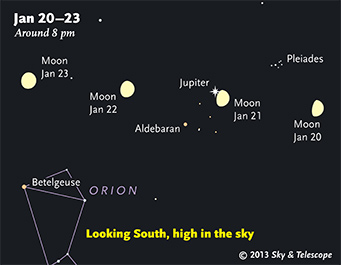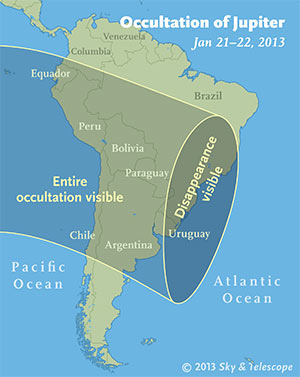Contacts:
Alan MacRobert, Senior Editor, Sky & Telescope
855-638-5388 x2151, [email protected]
Tony Flanders, Associate Editor, Sky & Telescope
855-638-5388 x2173, [email protected]
| Note to Editors/Producers: This release is accompanied by publication-quality illustrations; see details below. |
Stargazers in the Americas have an extraordinary opportunity on the night of Monday, January 21, 2013. Jupiter, the second-brightest planet, will appear less than a finger-width from the Moon throughout North America. And in much of South America, the Moon will actually pass right in front of Jupiter, hiding it from view.
The pair is already very close together at sunset. The time of their closest approach on the evening of January 21st depends on your location; it's around 7 p.m. in the Pacific time zone, 8:30 p.m. Mountain, 10 p.m. Central, and 11:30 p.m. Eastern time. To find out when the Moon occults (hides) Jupiter for selected locations in South America, see the International Occultation Timing Association website.
Although the Moon and Jupiter look close together, they’re definitely not. The Moon is 1.3 light-seconds (250,000 miles) distant from Earth. Jupiter is 1,700 times farther away in the background, at a distance of 37 light-minutes. Nevertheless, the pair make for an amazing sight to the unaided eye, through binoculars, or through a small, wide-field telescope at magnifications of 40× or lower.
"You'll also get an opportunity to attempt an unusual feat: spotting Jupiter in the late afternoon, before the Sun sets," says Tony Flanders, associate editor at Sky & Telescope magazine and host of SkyWeek on PBS. "First locate the Moon medium-high in the east; then look a few Moon-widths left or lower left of the Moon for Jupiter. It should be easy to spot with binoculars if the air is clear."
Telescope owners have a couple of additional treats. Jupiter's Great Red Spot is visible roughly from 9:00 to 10:40 p.m. EST (6:00 to 7:40 PST). And Jupiter's moon Europa crosses in front of the planet from 8:13 to 10:37 p.m. EST (5:13 to 7:37 p.m. PST). Europa is well camouflaged against Jupiter's bright disk, but it should be easier to spot Europa's tiny black shadow crossing Jupiter from 10:22 p.m. to 12:46 a.m. EST (7:22 to 9:46 p.m. PST).
As icing on the cake, the bright orange star Aldebaran shines to the lower left of Jupiter and the Moon. "Binoculars show that the entire event takes place on the outskirts of the Hyades, the closest true star cluster to Earth," says Sky & Telescope senior editor Alan MacRobert. "The lovely Pleiades cluster lies nearby."
If you miss this conjunction, there will be another fine Jupiter-Moon conjunction on March 17th.
Sky & Telescope is making publication-quality illustrations available to our colleagues in the news media. Permission is granted for one-time, non-exclusive use in print and broadcast media, as long as appropriate credit (as noted in the caption) is included. Web publication must include a link to www.SkyandTelescope.com.
 Jupiter dances with the Moon on the evening of January 21, 2013. This diagram shows the appearance of the pair from January 20th through January 23rd, looking south, high in the evening sky. Click the image for a high-resolution version. Click here for a version formatted for HDTV. Sky & Telescope diagram |
 What appears north of the equator as a close conjunction between Jupiter and the Moon becomes a full occultation in South America. In most of the occultation track, Jupiter passes behind the Moon and re-emerges. But within the oval on the eastern end, the Moon sets while Jupiter is still hidden, so only Jupiter's disappearance is visible. Click the image for a high-resolution version. Sky & Telescope diagram |
For skywatching information and astronomy news, visit SkyandTelescope.com or pick up Sky & Telescope, the essential guide to astronomy, with subscribers in more than 100 nations. Sky Publishing (a New Track Media company) was founded in 1941 by Charles A. Federer, Jr. and Helen Spence Federer, the original editors of Sky & Telescope magazine. In addition to Sky & Telescope and SkyandTelescope.com, the company publishes two annuals (SkyWatch and Beautiful Universe) as well as books, star atlases, posters, prints, globes, apps, and other fine astronomy products.
 0
0
Comments
You must be logged in to post a comment.